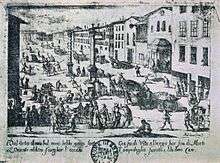1629–1631 Italian plague
The Italian Plague of 1629–1631 was a series of outbreaks of bubonic plague that ravaged northern and central Italy. This epidemic, often referred to as the Great Plague of Milan, claimed possibly one million lives, or about 25% of the population.[1] This episode is considered one of the later outbreaks of the centuries-long pandemic of bubonic plague that began with the Black Death. The plague may have contributed to the decline of Italy's economy relative to that of other Western European countries.[2]

Outbreaks
German and French troops carried the plague to the city of Mantua in 1629 as a result of troop movements associated with the Thirty Years' War (1618–1648). [3] Venetian troops, infected with the disease, retreated into northern and central Italy, spreading the infection.
In October 1629, the plague reached Milan, Lombardy's major commercial center. Although the city initiated effective public health measures, including quarantine and limiting the access of German soldiers and trade goods, the plague smoldered. A major outbreak in March 1630 resulted from relaxed health measures during the carnival season. This was followed by a second wave in the spring and summer of 1631. Overall, Milan suffered approximately 60,000 fatalities out of a total population of 130,000.
East of Lombardy, the Republic of Venice was infected in 1630–31. The city of Venice was severely hit, with recorded casualties of 46,000 out of a population of 140,000. Some historians believe that the drastic loss of life, and its impact on commerce, ultimately resulted in the downfall of Venice as a major commercial and political power. The papal city of Bologna lost an estimated 15,000 citizens to the plague, with neighboring smaller cities of Modena and Parma also being heavily affected. This outbreak of plague also spread north into Tyrol, an alpine region of western Austria and northern Italy.
Later outbreaks of bubonic plague in Italy occurred in the city of Florence in 1630–1633 and the areas surrounding Naples, Rome and Genoa in 1656–57.
Population before the plague and death toll, selected cities:[1]
| City | Population in 1630 | Death estimates by 1631 | Percentage of population lost |
|---|---|---|---|
| Verona | 54,000 | 33,000 | 61% |
| Milan | 130,000 | 60,000 | 46% |
| Venice | 140,000 | 46,000 | 33% |
| Bologna | 62,000 | 15,000 | 24% |
| Florence | 76,000 | 9,000 | 12% |
A 2019 study found that the plague of 1629–1631 led to lower growth in several cities affected by the plague and "caused long‐lasting damage to the size of Italian urban populations and to urbanization rates. These findings support the hypothesis that seventeenth‐century plagues played a fundamental role in triggering the process of relative decline of the Italian economies."[4]
Literature
The 1630 Milan plague is the backdrop for several chapters of Alessandro Manzoni's 1840 novel The Betrothed (Italian: I promessi sposi). Although a work of fiction, Manzoni's description of the conditions and events in plague-ravaged Milan are completely historical and extensively documented from primary sources researched by the author.
An expunged section of the book, describing the historical trial and execution of three alleged "plague-spreaders", was later published in a pamphlet entitled Storia della colonna infame (History of the pillar of infamy).
See also
- List of epidemics
- Santa Maria della Salute, a church in Venice built as a votive offering for the city's deliverance from the plague
- Lazzaretto Vecchio, small island in the Venetian lagoon used as a cemetery for plague victims
References
- Hays, J. N. (2005). Epidemics and pandemics their impacts on human history. Santa Barbara, California: ABC-CLIO. p. 103. ISBN 978-1851096589.
- Alfani, Guido (2013-11-01). "Plague in seventeenth-century Europe and the decline of Italy: an epidemiological hypothesis". European Review of Economic History. 17 (4): 408–430. doi:10.1093/ereh/het013. ISSN 1361-4916.
- Kohn, George C. (2007). Encyclopedia of Plague and Pestilence: From Ancient Times to the Present (3rd ed.). New York: Facts on File. pp. 200.
- Alfani, Guido; Percoco, Marco (2019). "Plague and long-term development: the lasting effects of the 1629–30 epidemic on the Italian cities" (PDF). The Economic History Review. 0 (4): 1175–1201. doi:10.1111/ehr.12652. ISSN 1468-0289.
- Cipolla, Carlo M. (1981). Fighting the Plague in Seventeenth Century Italy. Madison: University of Wisconsin Press. ISBN 0-299-08340-3.
- Prinzing, Friedrich (1916). Epidemics Resulting from Wars. Oxford: Clarendon Press.